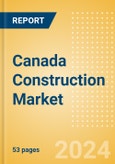However, monetary easing is beginning to take effect in the real economy with investment in residential building construction, measured in seasonally adjusted constant prices, increasing by 2.4% year-over-year (YoY) in January 2025. Similarly, investment in non-residential building construction experienced a 2.7% YoY rise over the same period. As the Bank of Canada continues to reduce interest rates, closer to the 2% mark, a return of demand in the Canadian construction industry is expected.
The analyst expects the industry to register an annual average rate of 2.8% during 2026-29, supported by developments in the energy, transport, industrial, and residential sectors. Growth will also be supported by the government’s plan to reduce Greenhouse gases (GHG) emissions by 45-50% by 2035, as compared to 2005 levels. Additionally, the country then aims to achieve net-zero emissions by 2050 and will look to invest in renewables over the forecast period. In December 2024, the government of British Columbia approved nine new wind energy projects, which aim to increase the province’s electricity production by 8% annually. The projects will generate 5,000 gigawatt-hours of electricity annually, equivalent to the consumption of 500,000 homes.
These projects are estimated to generate $5 to $6 billion in private investment and are expected to be completed by 2031. Additionally, the industry’s growth will also be supported by the Investing in Canada Plan, which was launched in 2016. According to the plan, the government intends to invest a total of CAD180 billion ($131.9 billion) in energy systems infrastructure, internet networks, trading ports, and public transportation by 2028. However, following the resignation of Justin Trudeau in January 2025 and the upcoming General Election, which must take must before October 20th, 2025, any Canadian Government program could face substantial revisions.
This will be dependent on whether Mark Carney or Pierre Poilievre assume the top job, come the end of the year. Regardless of whether the Liberal party or the Conservatives will the election, the industry’s growth over the forecast period is expected to be supported by investments in public housing projects, in line with the current government target to build 5.8 million houses by 2030.
Construction in Canada - Key Trends and Opportunities to 2029 (Q1 2025) report provides detailed market analysis, information and insights into the Canadian construction industry, including:
- The Canadian construction industry's growth prospects by market, project type and construction activity
- Critical insight into the impact of industry trends and issues, as well as an analysis of key risks and opportunities in the Canadian construction industry
- Analysis of the mega-project pipeline, focusing on development stages and participants, in addition to listings of major projects in the pipeline.
Scope
This report provides a comprehensive analysis of the construction industry in Canada. It provides:
- Historical (2020-2024) and forecast (2025-2029) valuations of the construction industry in Canada, featuring details of key growth drivers.
- Segmentation by sector (commercial, industrial, infrastructure, energy and utilities, institutional and residential) and by sub-sector
- Analysis of the mega-project pipeline, including breakdowns by development stage across all sectors, and projected spending on projects in the existing pipeline.
- Listings of major projects, in addition to details of leading contractors and consultants
Reasons to Buy
- Identify and evaluate market opportunities using our standardized valuation and forecasting methodologies
- Assess market growth potential at a micro-level with over 600 time-series data forecasts
- Understand the latest industry and market trends
- Formulate and validate business strategies using critical and actionable insight
- Assess business risks, including cost, regulatory and competitive pressures
- Evaluate competitive risk and success factors








